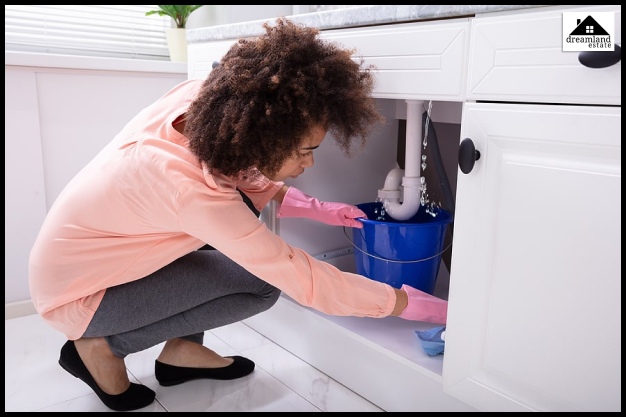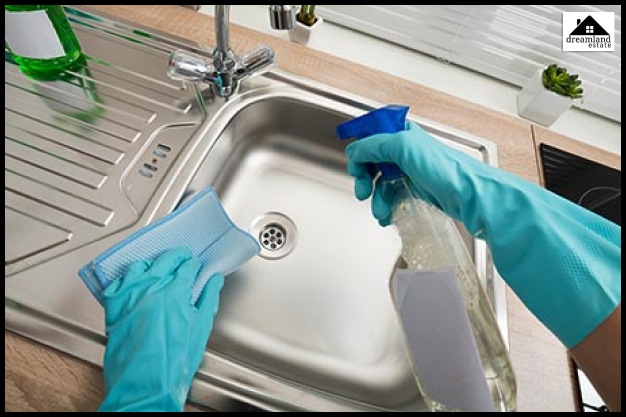Kitchen Sink Disaster? Learn How to Fix a Leak Under the Sink

If you ever see your kitchen floor have puddles of water everywhere, your kitchen sink might be leaking right now. Unfortunately, this is common in most households, especially if you last cleaned and fixed your sink a year ago.
Therefore, always watch for a leaking sink in your kitchen. If left unnoticed and unfixed, it can lead to more problems. Therefore, fix the leaking sinks as soon as possible.
If you don’t know how to fix a leaking sink in your kitchen, fret not because we have covered you.
Start reading this blog to find out what causes kitchen sink leaks and how to fix a leak under the sink. In addition, if you need help cleaning it, you could do so after going through this article.
Click Here To Read Out: Why Your Kitchen Countertops Matter
The Reason Behind The Leak Under Kitchen Sink
There are various reasons why you have a leaking sink in your kitchen. However, some of the most common reasons are,
1. Drainage Leakage
Every kitchen sink has a drainage system that allows the water to flow outside. Having a proper drainage system is very important. This is because drainage helps you empty the dirty water from your sink after washing your dishes.
If there is no drainage outflow, all the dirty water will start clogging your pipes. This can lead to more problems down the line since it will just increase your problems.
Sometimes, it’s the plumber’s putty that causes the problem. For example, when you install a kitchen sink for the first time, the plumber will always put some putty in the drainage pipe on the sink. This prevents it from opening up and even seals the sides for proper drainage.
To check your drain for problems, simply fill your sink with water to the brim. Then, unplug the sink and watch where the leak happens from.
2. Kitchen Sink Faucets Leak
If you see a puddle of water around the faucet whenever you turn it on, you have a leaking faucet. However, the problem lies in the leak that can originate anywhere. Therefore, it will be pretty troublesome if the leak is happening under the faucet where you can’t look at it.
These faucet leaks can happen because of worn-out washers and gaskets. Replacing your kitchen sink faucets typically solves the problem. However, if the leak is below the sink counter, then you need special measures and the help of a plumber.
Read More: Top Kitchen Trends To Consider For Your Next Renovation Project
3. Damaged Water Supply
Your kitchen sink gets its water supply from another pipe that is connected to your water tank. Typically, your sink will have two water supplies, with the third one being a separate supply for your sprayer. You will be in a lot of trouble if there is a leak from all your water supply pipes.
To identify the source of the leak, you will have to see how much water is leaking every day. If there’s a lot of water leaking consistently every day, it is your water supply or drainage system.
Corroded or worn-out pipes can cause leaks and a non-operational gasket in the connector pipe. In addition, you must assess the source of the leak quickly since the leaking water can be soaked by the wood of the cabinet, eroding it slowly over time.
4. Clogged Water Pipes
Under your kitchen sink, you might find a p-shaped water pipe known as the p-trap. This pipe is why you don’t get any bad smell coming from your sink. The p-trap flushes everything down correctly and prevents the foul odors from congesting the pipes.
However, over time, small pieces of food and other water materials may congregate at the bend in the p-trap. In addition, if you have a p-trap made out of steel or iron, it can also become rusted and corroded. Therefore, check for clogged and eroded pipes under the sink.
5. Damaged O Rings
If you carefully look at your faucet handle, you will; notice that it has an o-shaped ring around it that holds it in place. It features a stem screw along with a disc. The o-ring can get loose over time, which is pretty standard after a year of use.
This causes the faucet to leak near the handle every time you turn it on. Therefore, simply changing your faucet or the o-ring can help solve this problem. However, this problem is most common amongst cartridge-type faucets.
6. Your Washers Are Worn Out
Washers are the rings inside the faucet that gets pressed whenever we use it. Over time, these washers get worked out, forcing you to either replace the faucet or simply replace the washer.
If you want to know whether your washer gets worn out or not, simply notice the area around the spouts of the faucet. If you see water leaking from there every time you turn on the faucet, there is a problem with the washer, and you need to call a plumber.
You May Like To Read This: 5 Ways To Maintain Your Garbage Disposal
7. The Valve Seat Has Corroded
A similar problem to the one mentioned above, the valve seat gets pressed by the washer when you turn on the faucet. Both the washer and the valve seat get corroded due to friction when they contact each other.
This happens pretty frequently in households because the primary compression mechanism of the faucet lies between the valve seat and the washer. Since this mechanism gets activated each time you open the faucet and water runs down through it, erosion due to running water causes the faucet to get damaged and start leaking water all over.
How To Fix A Leak Under Your Kitchen Sink?
After reading the previous section, you must have found out which parts of your sink are leaking. Not that you are ready to repair your kitchen sink, here are the best ways to do so,
1. Locating The Leak
The first step you need to locate the fault with your kitchen sink. This will help you understand where the leak is coming from and what you should do next to fix it.
To find where the leak is coming from, check the sink cabinet and the faucet pipes. After you find the source of the leak, you can try and open up the part with a wrench.
We do not recommend doing this since you can make matters worse if you have never done it before. Instead, call a plumber to make things easier.
2. Assessing The Situation
After locating the leak, you must assess what is wrong with the part from where the leak is coming from. For example, if the leak comes from a pressurized valve, it will spray water everywhere like a fountain.
However, this is not easy since assessing the situation might need professional help from plumbers to make the correct assumptions.
In addition, try out some other methods like filling up the sink full of water. This will help you assess whether it’s the sink’s drainage system that requires special attention. For example, if you see a puddle of water at the bottom of your cabinet, your pipes are in danger.
3. Fixing Leaks In Water Supply
Your sink faucet is connected with a pipe to your overhead tank, where water is stored. So if you see a water leak behind the faucet above the kitchen sink, be sure that your water supply pipe is leaking.
You need to fix the leak on the pipe by applying putty around the leaking area. However, you can also get the entire pipe replaced, which raises your bill a lot. Therefore, depending on the severity of the situation, make the correct choice after asking your plumber for recommendations.
4. Fixing Faucet Leaks
If there is a problem with your faucet, then you should learn how to unclog your kitchen sink by doing two things:
- Replace the entire faucet with a new one if the older one is pretty old.
- If you do not want to replace the faucet, you can return the valve seats, the o-ring, and the washers. We recommend calling a plumber for this job as they will be able to assess the situation better and provide the best solution.
5. Fixing Water Drainage Leaks
If you see a lot of water on the bottom of the sink cabinet, then know that your drainage pipe is damaged. Get a plumber immediately to check your pipes and let them assess the situation.
In this situation, you can try to get the pipes fixed yourself with a bit of effort. However, to do so, you must,
- Use pliers to remove the old drain seal. Next, gently apply a new adhesive around the drain seal, which should be barren right now.
- Now gently place the new drain seal on the adhesive and make sure they are stuck tightly.
How To Clean Your Kitchen Sink?
Fixing a leak in your black kitchen sink can become tiring after doing it a few times. Therefore, keeping your sink clean at all times is a necessity to prevent leaks and fixes in the first place.
But what are the best techniques to keep your sink clean at all times? Just continue reading!
1. Scrub And Rinse Until It Shines
Use a scrub and a liquid soap to scrub off any dirt on your sink. Use liquid soaps since they are easier to use with a scrubber. Then, near the nooks and crannies, use a jet spray to allow the water to enter the tough-to-reach areas of the sink pipes.
Since there are various types of pipes, you can use additional ingredients to make them shine as if they are brand new. For this, you can.
- Use vinegar, water paste, and baking sodas to clean stainless steel kitchen sinks.
- If you have a kitchen sink made of porcelain, copper, or granite, then simply use warm water with soap. Do not scrub in this scenario since it can damage them.
- If you have a kitchen sink made with enamel cast iron, then use any cleaning method that does not involve using a scrub. Instead, use a towel and warm water with a dash of liquid soap.
You May Also Like To Read This: Top 10 Best Kitchen Diner Ideas
2. Don’t Forget The Nooks And Crannies
Use an old toothbrush as a scrub to clean the hard-to-reach nooks and crannies of the kitchen sink. This is useful for cleaning areas around the pipes, faucets, and spray nozzles. We recommend using deep clean brushes with vinegar.
3. Spray Some Disinfectants
After you clean the undermount kitchen sink, you can spray some disinfectants over it. This makes sure that no germs can build up in your sink, and it always remains clean and dirt free.
Alternatively, you can use a disinfectant with vinegar in a 1:1 ratio and wash the area around the sink with a towel. Use soap instead of vinegar if you have old kitchen sink cookies since they might get rusted and corroded due to vinegar.
4. Clean Your Tools Too
As a final touch-up, clean all the tools you used to fix the leak in your kitchen sink. This way, you can ensure that no germs get stuck on your wrenches and other repair tools.
Frequently Asked Questions (FAQs):
Q1. What Is The Average Cost To Replace A Kitchen Sink?
The average cost of repairing the kitchen sink is between $200 to $600.
Q2. What Is The Standard Kitchen Sink Size?
The standard size for kitchen sinks is between 30 inches to 34 inches.
Q3. Will A Plumber Install A Kitchen Sink?
Yes, a plumber will be able to install a kitchen sink.
Q4. Can You Put An Undermount Sink On Top Of Counter?
You can only do so if you have a granite kitchen sink.
Tidying Up!
Cleaning your kitchen sink is no easy task, considering that there can be more than one problem with your sink. Therefore, first, you need to ass4ss the situation and check the problem with the sink.
After that, fix the sink in the order explained above, depending on what’s damaged. In addition, don’tṣ forget to clean your sink and tools after repairing them to ensure that they are not damaged.
Read Also:













Leave A Reply